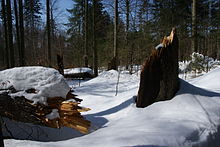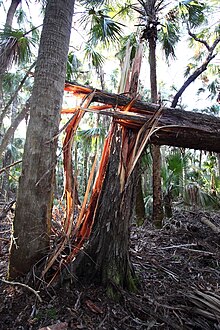Windthrow
A common way of quantifying the risk of windthrow to a forest area is to model the probability or 'return time' of a wind speed that would damage those trees at that location.
[3] Windthrow disturbance generates a variety of unique ecological resources on which certain forest processes are highly dependent.
Windthrow can be considered a cataclysmic abiotic factor that can generate an entire new chain of seral plant succession in a given area.
Additionally, the gap created in the forest canopy when windthrow occurs yields an increase in light, moisture, and nutrient availability in near proximity to the disturbance.
[3] The advent of trees roughly 370 million years ago led to dramatic ecosystem changes, as before then bedrock weathering was too slow to maintain thick soils in hilly terrain.




